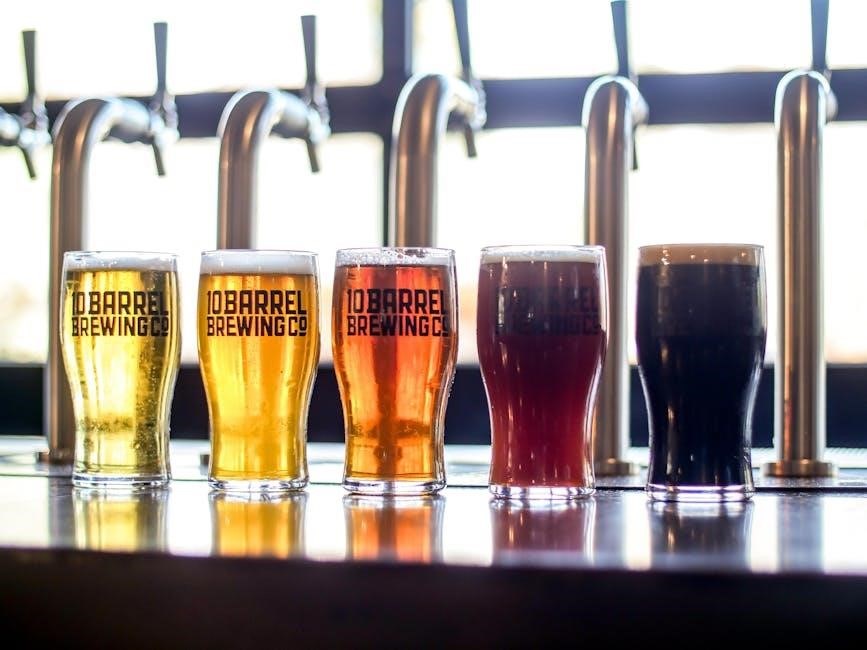Tap and Barrel: A Guide to Nutritional Information
Tap and Barrel is committed to providing guests with comprehensive nutritional information. While a downloadable PDF isn’t available, their online tool offers details on menu items. This resource allows informed choices, supporting various dietary needs and preferences for a balanced dining experience.
Tap and Barrel, a popular dining establishment known for its vibrant atmosphere and diverse menu, strives to create meaningful and memorable experiences for its guests. With multiple waterfront locations across Vancouver and surrounding areas, Tap and Barrel offers a unique blend of comfort food and a lively social setting. Central to their mission is a commitment to transparency, particularly concerning the nutritional content of their offerings.
Understanding that many patrons are mindful of their dietary choices, Tap and Barrel provides accessible nutritional information to help individuals make informed decisions. While they may not offer a traditional downloadable PDF, they provide a convenient online tool where guests can find details on the calorie count, macronutrient breakdown, and other relevant nutritional facts for various menu items. This reflects a dedication to catering to diverse dietary needs and preferences, ensuring everyone can enjoy their experience. This approach allows guests to navigate the menu with confidence, aligning their dining choices with their health and wellness goals.
Accessing Nutritional Information Online
Tap and Barrel understands the importance of readily available nutritional information for its customers. To facilitate informed dining choices, Tap and Barrel provides an online platform where guests can easily access detailed nutritional facts for their menu items. While a downloadable PDF is not currently offered, the online tool is designed for user-friendly navigation and comprehensive information retrieval.
Customers can visit the Tap and Barrel website and locate the nutritional information section, typically found within the menu or health & wellness area. Within this section, users can search for specific dishes or browse through menu categories to find the nutritional details they require. The information provided usually includes calorie counts, macronutrient breakdowns (fat, carbohydrates, protein), and other relevant data like sodium content and allergen information. This online accessibility allows guests to plan their meals in advance, catering to their dietary needs, preferences, or restrictions. By offering this digital resource, Tap and Barrel empowers its customers to make conscious food choices and enjoy their dining experience with complete peace of mind.
Tap and Barrel Burger Nutritional Details
Tap and Barrel’s burger selection is a popular choice among patrons, and the restaurant provides nutritional details to help customers make informed decisions. While a comprehensive PDF may not be directly available, detailed information can be accessed through their online platform.
The online tool allows users to search for specific burger options and view their corresponding nutritional breakdowns. Typically, this includes the calorie count, grams of fat (including saturated and trans fats), carbohydrate content, protein levels, and sodium amounts. The nutritional information provided aims to offer transparency, enabling guests to understand the composition of their chosen meal. This is especially useful for individuals monitoring their calorie intake, managing specific macronutrient ratios, or adhering to dietary restrictions.
For example, a customer can easily find the calorie count for the “Tap Burger” or the “Braised Short Rib Burger” on the website. Moreover, the online tool might also provide insights into potential allergens present in each burger, assisting those with food sensitivities or allergies. By offering this level of detail, Tap and Barrel ensures that customers can confidently select a burger that aligns with their nutritional goals and preferences.

Specific Burger Options and Nutritional Content
Tap and Barrel offers a diverse range of burger options, each with its unique flavor profile and nutritional composition. To assist customers in making informed choices, the restaurant provides detailed nutritional information for each burger on their menu through their accessible online tool.
For instance, the classic “Tap Burger,” featuring certified Angus beef, aged white cheddar, lettuce, caramelized onions, tomato, house mayo, and pickles, will have a specific calorie count, fat content, carbohydrate level, and protein amount listed. Similarly, the “Braised Short Rib Burger,” with braised BBQ short rib, garlic mayo, smoked mozzarella, hickory sticks, BBQ sauce, and pickled jalapeno, will have its own distinct nutritional profile available online.
The “PB&J Burger,” a creative combination of certified Angus beef, bacon jam, chipotle peanut butter, lettuce, tomato, and house mayo, will also have its nutritional values readily accessible. This level of detail extends to all burger variations offered by Tap and Barrel. By providing this comprehensive information, customers can compare the nutritional content of different burger options and select the one that best aligns with their individual dietary needs and preferences.
Tap Burger
The Tap Burger, a signature offering at Tap and Barrel, is crafted with a focus on quality ingredients and a balanced flavor profile. This burger features a 1950 certified Angus beef patty, known for its rich taste and tenderness. It is topped with aged white cheddar, adding a sharp and creamy element to the burger. Fresh lettuce and tomato provide a crisp and juicy contrast to the savory beef and cheese.
Caramelized onions contribute a touch of sweetness and depth of flavor, while the house mayo adds a creamy and tangy component. Pickles offer a burst of acidity, completing the burger’s flavor profile. All of these ingredients are served on a brioche bun.
For those conscious about their nutritional intake, Tap and Barrel provides detailed information about the Tap Burger’s nutritional content through their online tool. This includes the calorie count, fat content, carbohydrate level, protein amount, and other relevant nutritional values. By offering this information, Tap and Barrel enables customers to make informed decisions.
Braised Short Rib Burger
The Braised Short Rib Burger at Tap and Barrel is a hearty and flavorful option for those seeking a more indulgent experience. This burger features a 2195 certified Angus beef patty, topped with tender braised BBQ short rib. The short rib is slow-cooked to perfection, resulting in a melt-in-your-mouth texture and rich, smoky flavor. Garlic mayo adds a creamy and savory element to the burger, while smoked mozzarella provides a smoky and gooey cheese experience.
Hickory sticks contribute a crispy and smoky element, while BBQ sauce adds a touch of sweetness and tanginess. Pickled jalapenos offer a spicy kick, balancing out the richness of the other ingredients. The combination of these ingredients creates a complex and satisfying flavor profile.
Tap and Barrel offers nutritional information for the Braised Short Rib Burger through their online tool. This includes details on calories, fat, carbohydrates, and protein. This allows customers to make informed choices based on their dietary preferences and needs.
PB&J Burger
The PB&J Burger at Tap and Barrel is an adventurous and playful take on the classic peanut butter and jelly sandwich, reimagined as a savory burger. This unique burger features a 2050 certified Angus beef patty, topped with a bacon jam that adds a smoky and sweet element.
The chipotle peanut butter brings a creamy, nutty, and slightly spicy flavor to the burger, creating an unexpected and delightful combination. Lettuce and tomato add freshness and a touch of acidity, while the house mayo provides a creamy and tangy base. The burger is served on a brioche bun, which is soft and slightly sweet.

This innovative burger offers a balanced blend of sweet, savory, and spicy flavors. While some may find the combination unconventional, it is a popular choice for those seeking a unique and memorable dining experience. Tap and Barrel provides nutritional information for the PB&J Burger through their online tool. This allows customers to be aware of the calorie count, fat content, and other nutritional aspects of the burger.
Other Menu Items and Nutritional Information
Beyond burgers, Tap and Barrel boasts a diverse menu featuring items like the Halloumi Power Bowl, Ranchero Rice Bowl, and Maple Dijon Glazed Salmon. For health-conscious diners, the Halloumi Power Bowl is a popular choice. It includes seared halloumi cheese, quinoa, kale, spinach, avocado, and an assortment of vegetables.
Seafood lovers may enjoy the Maple Dijon Glazed Salmon, which offers a balance of protein and healthy fats. Tap and Barrel is committed to providing nutritional information for these and other menu items through their online tool. This allows customers to make informed choices based on their dietary needs and preferences.
Whether you’re interested in calorie counts, macronutrient breakdowns, or allergen information, Tap and Barrel’s online resource provides a convenient way to access the details you need. By offering this transparency, Tap and Barrel aims to empower guests to enjoy their dining experience while staying mindful of their health and wellness goals. Remember to check their website for the most current and detailed nutritional information.
Allergies and Dietary Restrictions
Tap and Barrel understands the importance of catering to various allergies and dietary restrictions. While they don’t offer a specific gluten-free menu like some establishments, they encourage guests to inform their server about any allergies or dietary needs. This allows the staff to provide personalized recommendations and ensure a safe dining experience.
The online nutritional information tool can also be helpful for identifying potential allergens in specific dishes; Guests can review the ingredients and nutritional content of each menu item to determine if it aligns with their dietary requirements. For example, individuals with peanut allergies should be aware of the PB&J Burger, which contains chipotle peanut butter.
Furthermore, Tap and Barrel is generally accommodating to modifications, allowing guests to customize their orders to meet their needs. Whether it’s omitting a specific ingredient or requesting a substitution, the restaurant strives to provide options for those with dietary restrictions. It is always best to confirm details with your server.
Calorie Information for Select Items
Understanding the calorie content of your meal is essential for making informed dietary choices. Tap and Barrel provides calorie information for many of their menu items, allowing guests to track their intake and manage their overall diet. While a complete PDF of nutritional data isn’t available, their online tool offers a convenient way to access this information.
For example, the Tap Burger contains 951 calories, while the Braised Short Rib Burger is a more substantial option at 2195 calories. The PB&J Burger falls in between, offering 1995 calories. These figures can help diners choose options that align with their calorie goals.
Beyond burgers, Tap and Barrel also offers a variety of other dishes with varying calorie counts. For instance, the Maple Dijon Glazed Salmon contains 329 calories. The online menu provides details on the calorie content of select dishes, empowering guests to make choices that suit their needs. Remember to check the online tool for the most current figures.
Michelob ULTRA Amber Beer Nutritional Information
For those seeking a lighter beer option at Tap and Barrel, Michelob ULTRA Amber is a popular choice. This amber-colored beer boasts a relatively low calorie count, making it a suitable selection for calorie-conscious individuals. One serving (typically a standard bottle or draft pour) of Michelob ULTRA Amber contains approximately 89 calories.
In addition to its calorie content, it’s also helpful to know the carbohydrate and protein values. Michelob ULTRA Amber contains around 3.2 grams of carbohydrates. The beer contains a small amount of protein, around 0.9 grams per serving. With an alcohol by volume (ABV) of 4.0%, it offers a balanced flavor profile without excessive calories or carbohydrates.
This information allows patrons to enjoy a refreshing beer while remaining mindful of their nutritional intake. These details contribute to a more transparent and informed dining experience. Enjoy responsibly.
Contact Information for Tap and Barrel
For inquiries regarding nutritional information, reservations, or general questions, Tap and Barrel provides several avenues for contact. Direct communication ensures accurate and timely responses to customer needs. The primary phone number for Tap and Barrel is (208) 343-4900. Calling this number connects you with the restaurant’s staff, who can assist with immediate inquiries or direct you to the appropriate department.
Alternatively, Tap and Barrel maintains an active online presence through their website: www.tapandbarrel.com. The website serves as a central hub for information, including menus, locations, hours of operation, and special events. While a downloadable PDF of nutritional information may not be available, the website often features an online tool where you can search for specific menu items and view their nutritional details.
For additional assistance or specific concerns, customers can also reach out through the website’s contact form or social media channels.

Tap and Barrel strives to empower its patrons with the necessary information to make informed dining choices. By offering easily accessible nutritional details through their online platform, Tap and Barrel demonstrates a commitment to transparency and customer well-being. While a comprehensive PDF document may not be available, the interactive online tool allows guests to actively seek out the specific nutritional content of various menu items.
This approach enables individuals with dietary restrictions, allergies, or specific health goals to navigate the menu with confidence. Whether you’re counting calories, managing macronutrient intake, or simply curious about the ingredients in your favorite dish, Tap and Barrel’s online resources provide valuable insights.
Ultimately, Tap and Barrel’s dedication to providing nutritional information reflects their broader mission of creating a positive and inclusive dining experience for all guests. By promoting awareness and transparency, they encourage customers to enjoy their meals while remaining mindful of their health and dietary needs.






